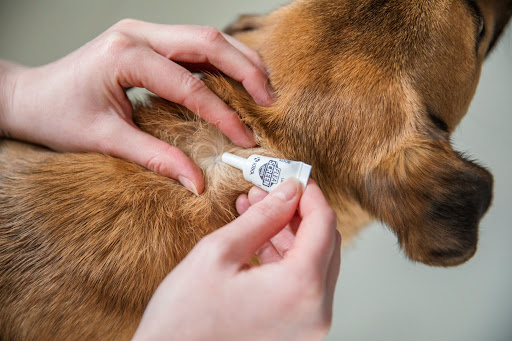There’s one question we see popping up time and again – what’s the best flea treatment for dogs?
We get it – nobody wants to face a flea infestation! So in this blog, we’re sharing top prevention tips to keep these pesky critters off your dog and out of your home.
Why does my dog need flea protection?
As well as irritating their skin, fleas feed on your dog’s blood. This means they’ll be feeling uncomfortable and could even be at risk of anaemia if they become heavily infested.
And you know what they say about prevention being the best cure?
It’s much easier to prevent an infestation than treat one – so using a year-round preventive treatment is essential to keeping your dog flea-free.
What’s the best flea treatment for dogs?
There’s a bewildering array of products out there: flea collars, flea spray, spot-on medications, shampoos, powders, even bombs! Which one should you pick?
There are two key factors to successful flea protection – consistency and correct dosage.
In other words, the best flea prevention for your dog is one that’s tailored to their needs, that you can easily remember to apply.
So…what’s the solution?
We’ve been there – flipping through the calendar, trying to remember the last time you protected your dog and what on earth you used…
So how do we add consistency and precision to our flea treatments?
Enter the tails.com Monthly flea, tick and worm treatment! Created by vets, as a tails.com subscriber you can log into your account and add it to your monthly deliveries, and we’ll deliver the exact quantity your dog needs, exactly when they need it.
Plus, this all-in-one treatment protects from:
- Fleas
- Ticks
- Worms*
- Lice

Arriving in a letterbox-friendly package as a handy reminder, you’ll never miss a month’s protection again – and keep those pesky pests at bay!
*This treatment doesn’t protect against lungworm – please speak to your vet to get this treatment prescribed.
Why isn’t my flea treatment working?
If you’re finding fleas on your dog despite using a flea treatment, there are a few things to check before worrying you’ve picked up a new strain of drug-resistant super flea!
Firstly it’s important to note that using flea treatment doesn’t mean fleas won’t ever land on your dog – instead, these fleas should die within 24 hours of jumping onto your pet.
If they are sticking around even with consistent protection, then it might be to do with one of the following:
Application error:
With spot-on treatments, the application of liquid to the skin is crucial. If most of the vial is squeezed on the coat rather than the skin, then it won’t be as effective. Or it will only be effective for a short time, leaving your pet prone to fleas before their next dose is due.
Make sure you’re parting the hair to find a nice, clean application spot.

Wash-off effect:
Have you washed your stinky hound after they’ve rolled in something pungent recently? If you applied flea treatment just before, there’s a high chance it’s now been washed off before it can be fully absorbed.
It’s best to leave 3-4 days after a spot-on treatment before bathing.
If your dog is a wild swimmer, it’s worth noting that flea treatments for dogs contain chemical pesticides that can be fatal to creatures that naturally live in rivers, lakes and ponds.
To protect wildlife, keep your dog on dry land for around 4-5 days after a treatment.
Environmental flea burden:
Maybe you’ve suddenly noticed your dog scratching and found fleas. But every day you’re finding more despite using treatment. Surely that must mean it’s not working?
Actually, adult fleas on dogs are the tip of the flea iceberg. Chances are there are hundreds more flea eggs and larvae in the environment, which continue hatching out weeks after an infestation is first noticed.
Using a suitable treatment AND treating your house at the same time is the only reliable way to tackle a sudden or heavy infestation. Even with effective flea prevention for dogs, you might see dead or dying fleas for a while afterwards.
Resistance?
Most suspected cases of flea resistance can be explained by one or more of the above issues. If you’ve addressed all of those and are still battling a flea problem, speak with your vet about using a different product to help your specific set of circumstances.
We hope this article helps you find the best flea treatment for you and your dog. Follow the above tips to keep these unwanted critters out of your home and off your dog!


I’m disappointed that, if you are promoting a more natural, chemical-free diet, you aren’t also suggesting natural flea treatments. Is this something you’ll be looking at in the future?
Hi Claire, like nutrition, when it comes to parasite protection, there is not a one size fits all solution. Our range allows us to cater for customers who need more support when it comes to dealing with these unwanted guests. We use industry expertise and recommendations from reliable sources such as the World Small Animal Veterinary Association when it comes to curating the protection we offer. To read more about the products we’re providing to protect against fleas, ticks, and worms just click here: https://help.tails.com/hc/en-gb/categories/5107483044113-Tails-com-Flea-Tick-Worm-Treatment
Is the worming element a spot on also, as I have great difficulty in getting either worming tablets or even liquid into my dog.
Hi Donna, we offer both the pipette and tablet to customers – to discuss further about what our veterinary team would recommend for your dog, please pop us an email to hello@tails.com with your details 💙
My goodness!
I’ve just realised that your treatment contains Fipronil.
A banned insecticide within the agricultural industry but still being used willing by the pet industry?!
This chemical has catastrophic consequences for all invertebrates.
Your warnings about swimming dogs are not adequate and Fipronil is not treated or removed by sewage companies so any residue from washing treated pets and even washing their bedding will mean that this insecticide will enter our rivers.
Please look at the scientific data you move away from using Fipronil in your product.
Hi Sam, we’d like to reassure you that we take our environmental responsibilities very seriously here at tails.com, and this is no different with our treatment.
We’re fully on board with POM-V treatments but for some owners, these aren’t always an option, so this enables us to provide an effective alternative and like most things, it’s a balancing act between all the different concerns and needs.
The impact on the environment is one of the reasons why we discourage owners from washing their pets after application and advise them to keep them away from water courses for a week or so after treatment, not only because it reduces efficacy, but also mitigates environmental impact. We work really closely with our vets, who take into account existing and new research and we’ll periodically review our recommendations to make sure we’re following best practice as we understand our responsibility to act as environmental stewards. Thank you for taking the time to give us feedback here and we’ll make sure to raise this with our team. Best wishes